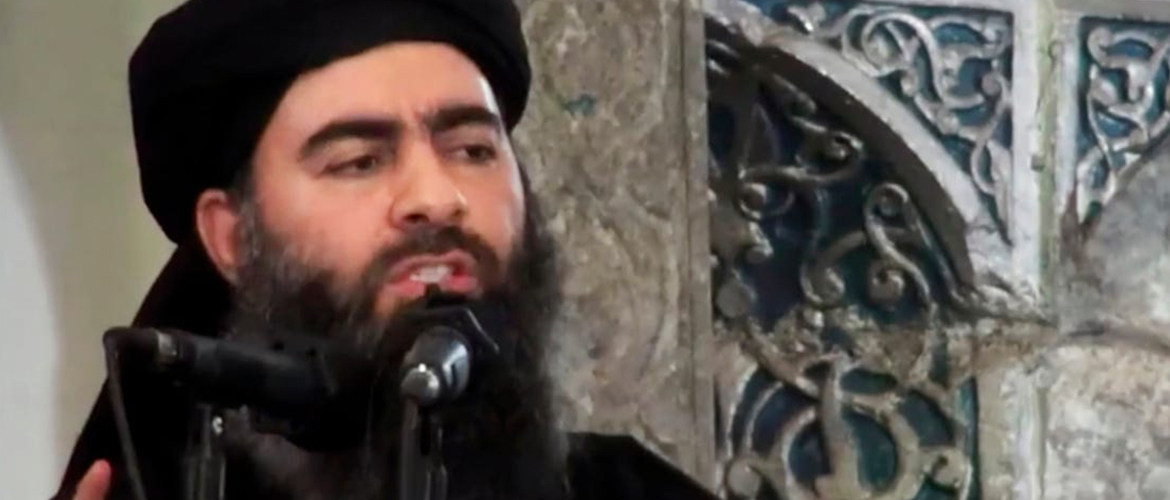A Caliphate sans Al Baghdadi
October 31, 2019 | Expert Insights

Background
A triumphant U.S President announced to the world the demise of the Islamic State Group leader, Abu Bakr al Baghdadi at the hands of US Special Forces in the remote dusty village of Barisha in Idlib province of North-West Syria.
48 years old Baghdadi, suffering from wounds and diabetes, was known to be hiding in Idlib province, moving frequently and changing hideouts. He was tracked by Kurdish operatives in a joint operation with the US which ultimately led to his detonation of an explosive vest to avoid capture by US forces.
At the peak of its power, the Caliphate controlled sizeable territory on the Iraqi Syria border with its headquarters in Mosul and later in Raqua. The American led intervention in the Syrian Civil war began in 2014, in support of the Syrian opposition and the federation of Northern Syria. Later US and its western allies focussed entirely on the ISIS, forging strong military ties with the Kurd dominated Syrian Defence Force (SDF) till the elimination of ISIS as a conventional military force in 2017. A large number of IS fighters are in the custody of SDF and balance have melted away in North-Western Syria, with some filtering down the lower Euphrates Valley. The IS remains active in the cyberspace.
Analysis
Like the mythical Hydra of Lerna, Baghdadi has been declared dead many times but has re-emerged again and again. So, it is not surprising that there are many sceptics who refuse to believe that he is finally dead. However, this time around President Trump says there is a DNA test to prove the same.
Three weeks ago, Trump had also announced the withdrawal of US troops from Syria, this had complicated the situation for the teams working on the capture of Baghdadi. The plan for the raid began sometime in July- August after the arrest and interrogation of one of Baghdadi’s wives. According to a US official the Syrian and Iraqi Kurds have provided more intelligence for the raid than any single country. In his speech, Trump also thanked Russia, Syria, Turkey and Iraq for their cooperation.
When US abandoned the Kurds to the Turks, former US Defence Secretary Ash Carter said that US had lost its key ally to fight the ISIS. He explained “The defeat of the ISIS was all but complete in 2017 when US enabled forces took Mosul and Raquaa, the two principal cities of the Caliphate. The remnants of ISIS were busy trying to stay alive, hiding in the deserts or drifting down the lower Euphrates Valley and the general belief was that ISIS could be kept suppressed. But now in the chaos that will ensue as the Turks and the Kurds go at each other, and the Russians move in, and Assad moves in, and the whole thing becomes much more scrambled. In that environment, ISIS will return. They will also have a base from which to operate, try to renew ISIS in Iraq and we will again have somewhere some barbarians again trying to stage their state. And when they threaten our people, which they will do as that is the part of their agenda, we will have to defend ourselves. But next time we won’t have anybody going with us, I am afraid to say.”
Does Baghdadi’s removal really mean anything for a group such as the ISIS? Strong leaders like Baghdadi add chutzpa to the image of the militant organisation and attract recruits, their lifeblood. However, their sudden demise does not automatically mean the end of the organisation itself.
These organisations exist on a wider ideology with religious fervour being the binding factory. Defeated and in disarray, Daesh was no longer the threatening monolith. It was only ideologically addressing a wider global congregation and forging ideological alliances with similar thinking jihadi groups in Africa, SE Asia and even South and Central Asia. Whilst these groups enjoy total independence and act on their own with local resources, ISIS gets to claim credit for their acts to project itself as the global jihadi fountainhead. It is far more active in the cyberspace than in the real world.
Counterpoint
Under pressure from the Democrats’ efforts to seek impeachment and dogged by controversies, President Trump desperately needs a spectacular achievement to boost his ratings for next year’s Presidential elections. His predecessor literally crafted his second term in office on the back of the Osama Bin Laden raid. Trump has called this raid an even bigger success and his campaign will surely try to extract the maximum mileage out of it.
Assessment
- Without doubt, Baghdadi as the Caliph was an important part of the ISIS structure, although over the last two years, his apparent sickness and constant flight from his pursuers, limited his ability to run the ISIS as a coherent organisation. His death per se may not destroy ISIS but it will make it less effective, especially in the short term, creating leadership voids, confusion and forcing replacement leaders to constantly scurry for cover rather than plot attacks.
- Further, it deprives the Caliphate of an impressive Caliph and his successor may not be as charismatic for prospective recruits. Nevertheless, a replacement will be in place, sooner than later.
- The ISIS, Al-Qaeda, is hydra-headed groups and ideas are bulletproof. The past few years of debilitation caused by the conflict in Syria and parts of Iraq leaves behind considerable chaos and unless there is competent governance in these regions, it is highly likely that these regions will once again spearhead new ideological movements.
- With, US withdrawal from Syria, and the Turkish offensive against Syrian Kurds have made the region once again a fertile ground for the rise of ISIS. Under Turkish pressure, the embattled SDF may just let the ISIS prisoners go. With a vacuum in North-Western Syria, ISIS may find a new stronghold to rise.
Image Courtesy: businessinsider.com








Comments